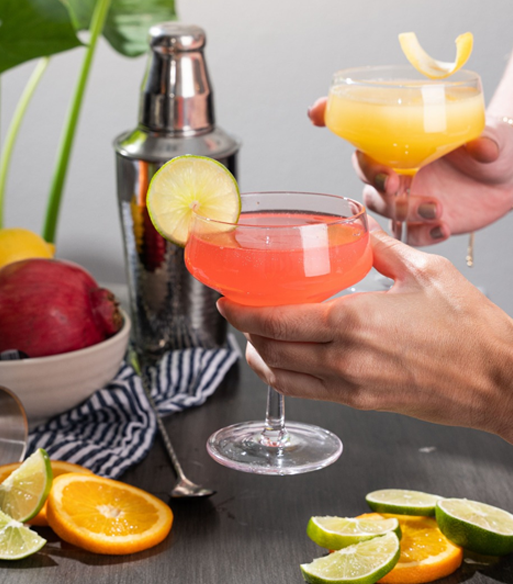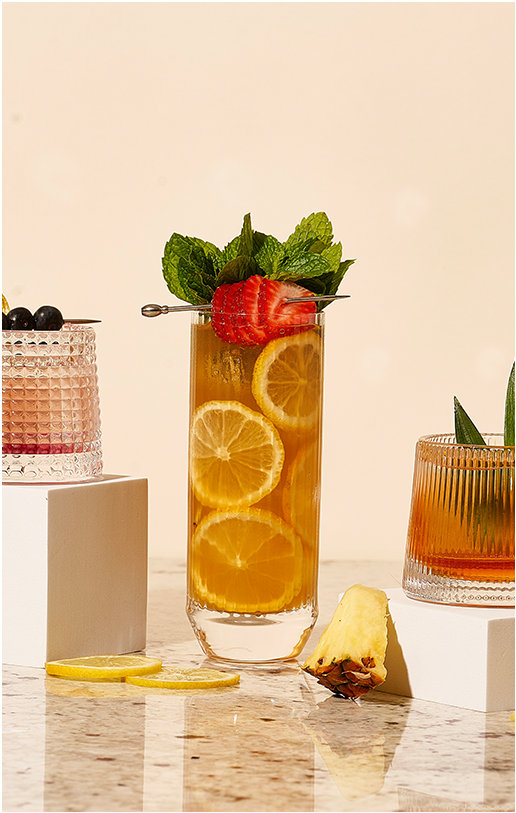Though from the same family, tequila and mezcal are different liquors. Tequila is the more commonly known liquor among cocktail enthusiasts because of its diverseness. Despite its relative obscurity, with its smoky flavoring, mezcal has gained traction in the cocktail industry since the 1990s. Mezcal has a surprisingly earthy aroma that draws inexperienced tasters in for more.
What is Tequila?
To use the name "tequila," distillers must meet specific requirements. Weber blue agave plants used to create tequila must be registered with Plantation Property Registry. The weber azule (blue) plant harnesses more sugar than any agave plant. Five states, including 180 municipalities, are protected by a Denomination of Origin to constrict where tequila is produced.
History of Tequila
We often hear the name Jose Cuervo when referencing tequila; after all, the Cuervo family was the first to distill tequila for consumption in the 1700s. However, Don Cenobio Sauza was the first to consider blue agave when developing tequila around the 1800s, making that species the new standard for tequila. In 1974, the Mexican government declared tequila as intellectual property, forming specific restrictions on the production process. These restrictions included five states in which production can develop, the method of manufacturing tequila, and regulations on ingredients utilized.
Methods of Making Tequila
The blue agave plant is the fastest to ripen, taking seven years to mature. The bulb is removed from the agave plant, chopped into quarters or halves, and steamed until soft. There are three types of ovens used today to cook the piña bulb, with stone ovens and autoclaves being the favorite.
- Horno de Tierra is built in an earthly pit surrounded by stone and is the most traditional form of cooking agave. This method is still used for mezcal today, but newer techniques have been implemented for crafting tequila because it was inefficient.
- Stone ovens were introduced to make the process more productive. These clay or stone ovens are packed with piña bulbs and fastened shut. The bulbs steam in the ovens, saving 2-3 days in work. This method is still commonly used today.
- Autoclaves are sealed steel tanks, similar to a pressure cooker. Cooking bulbs in autoclaves take between 6 and 12 hours, and it has the advantage of temperature control.
After the piña bulb is cooked, workers smash the remnants to separate sugars and extract agave liquids. To smash the bulbs, workers may use tahona (traditional milling stones pulled by a mule), Molina (mechanical mill via tractor), or diffusors (using pressure and steam). Diffusors are not suggested because they can strip the agave of all flavors leading to low-quality tequila.
The fermentation process follows the extraction of liquids and sugars. This process takes 1-3 weeks and usually occurs in wooden barrels or stainless steel tanks. After fermentation, distillation begins, completed in two or more rounds. Evaporation and condensation separate the ingredients by heating alcohol and water. Once separated, the alcohol drains into a separate pipe that leads to another pot for round two. Each time the distillation process transpires, the alcohol concentration levels increase. The minimum ABV required to be considered tequila is 35% or 70 proof.
The last step in making tequila is the aging process, which includes five timeframes:
- Blanco (Silver): 0-2 months of fermentation
- Joven (Gold): Blended mix of aged tequila and Blanco
- Reposado (Aged): Aged for 2 to 12 months
- Añejo (Extra Aged): Aged 1-3 years
- Extra Añejo (Ultra Aged): 3+ years
As the aging process occurs, the length spent in an oak barrel increases, which influences the flavor and color of each tequila. Blanco will be more earthy and sweet and often clear; Reposado has more oak flavor and is softer than Blanco; Añejo is a perfect balance of oak and sweetness and is darker in color.
Tequila mixes with a broader range of cocktail drinks and blends well with ice. Because of this, you will see more cocktails with tequila than with mezcal.
What is Mezcal?
Any agave plant in Mexico can be used to produce mezcal, but the liquor must be made with 100% agave. Mezcal's literal meaning is "cooked agave." Production of mezcal can only occur in Oaxaca, San Luis Potosi, Michoacan, Guerrero, Durango, Tamaulipas, Puebla, Zacatecas, and Guanajuato. One notable detail about mezcal is that it can only be bottled in the liquor's production plant. Mezcal is sweet, rich, and smoky in flavor, creating a unique blend for particular drinks.
History of Mezcal
Mezcal's history dates back to the indigenous people of Mexico. Ron Cooper traveled back-and-forth from California to Mexico, enjoying the culture which introduced the liquor to America. When Cooper tasted mezcal for the first time, he knew it was his opportunity to bring it back to the United States. In the mid-90s, Cooper brought mezcal into the United States in small doses. By 1995, he imported bottles and distributed mezcal throughout the U.S.
With mezcal's ever-growing popularity, agave shortages are a concern. Agave plants take about 7-9 years to fully mature, making it difficult for distilleries to meet the demand.
Methods of Making Mezcal
The piña bulb of an agave plant makes mezcal, and these bulbs must be ripe for developing the liquor. The traditional method of making mezcal includes roasting the bulb in hot earthy pits of lava rocks or wood, which creates the smoky flavor of mezcal. The cooking process takes about 4-6 days. Occasionally clay or stone ovens above ground may be used to cook the agave, but the traditional method is preferred to create the unique flavor of mezcal.
Similar to tequila, the next process involves separating sugars and juices. The first method involves a circular stone pit and a tahona wheel pulled by a mule. This process may take days, so this traditional method is rarely used. Instead, a more aggressive form of extraction takes place. A tool similar to a mallet is used to hand crush the bulb in a notched-out tree trunk.
Mezcal then enters the fermentation process in barrels or tanks, and it takes between one and three weeks. It runs identical to the fermentation process of tequila.
The distillation process for mezcal is the same technique as tequila. After separating contents, alcohol drips into another pipe, leading to a separate pot for the second round of distillation. The procedure happens at least twice, creating the minimum alcohol content level of 36%. With each further distillation, the ABV rises higher in value.
Mezcal is aged in oak barrels to create three varieties:
- Joven (Blanco or Abacado): 0-2 months
- Reposado Mezcal: 2-12 months
- Anejo Mezcal: 1 year minimum
As a result of the unique smoky flavor, mezcal pairs with more specific cocktails than tequila, and mezcal is served without ice. Ice can dilute the smoky flavor of the mezcal.
What are the Differences Between the Two?
Tequila is a type of mezcal; however, mezcal is not a type of tequila. Although the liquors are closely related in most areas, they have slight differences.
The core of the agave plant, also known as piña, produces tequila and mezcal. However, the weber blue agave plant creates tequila, while any agave plant creates mezcal. Since mezcal can use any agave plant, it opens production possibilities for mezcal. However, mezcal must be produced when the agave plant is ripe, and missing the ripeness can affect the flavor of mezcal. Mezcal must be made 100% agave, but tequila only demands 50% agave.
Because of the unique production process for both liquors, they tend to have two distinct flavors. Tequila has a more fruity and sweet flavoring, whereas mezcal is more savory and smoky. Traditional tequila is often made in an oven or steamed, while traditional mezcal is smoked in a pit (creating a smoky flavor) using lava rocks. Mezcal tends to run through the distillation process more than tequila to produce a higher alcohol content level. Tequila is produced in five states, while mezcal can be made in nine states. This broader area allows facilities to mass-produce mezcal quicker.
Featured Tequila and Mezcal Sourced Drinks
These are some of our most popular Mezcal and Tequila cocktails. We recommend them all!
Mezcal Sourced Cocktails
- Casamigos Mezcal Smokey Margarita - The smoky flavoring of the mezcal works beautifully with pineapple and passionfruit. Mixed with fresh-squeezed lime, cold-pressed pineapple juice, homemade passionfruit syrup, ad hellfire bitters, this margarita brings overtones of herbal and citrus while amplifying the agave taste.
- Oaxacan Old Fashioned - As it turns out, Mezcal and old fashioned get along famously. This is a south-of-the-border twist on one of the most iconic cocktails ever. The Oaxacan Old Fashioned uses Casamigos Mezcal instead of the traditional bourbon, giving this beverage a smokey, herbal taste.
Tequila Sourced Cocktails
- Casamigos Classic Margarita - The classic margarita is a fan favorite! Aged 7-9 years using 100% blue agave, the Casamigos Blanco Tequila, orange liqueur, fresh-squeezed lime juice, and homemade honey syrup create a spectacular blend for the cocktail admirer.
- Casamigos Blood Orange Paloma - Using Casamigos Blanco Tequila, the Blood Orange Paloma will leave you feeling rejuvenated! This cocktail mix is infused with fresh squeezed lime juice, blood orange juice, homemade simple syrup, and topped with soda water.
Reach out to Sourced Craft Cocktails today to try the difference between mezcal and tequila! Sourced Craft Cocktails has an option for you from classic to modern mixes!
 Delivery to:
Delivery to: 









